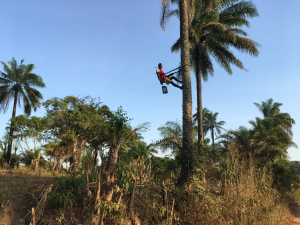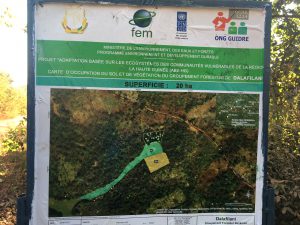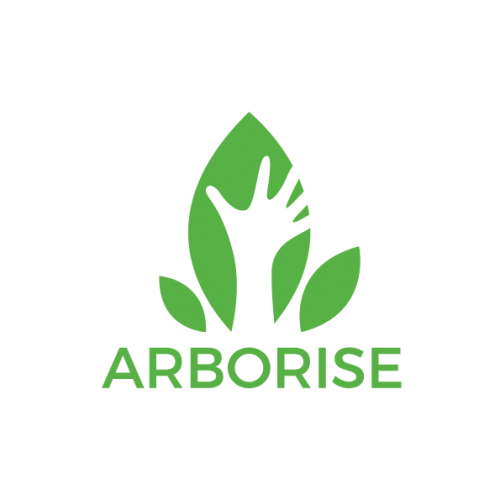Questions and Answers
Why upper Guinea?
- Guinea is the water tower of West Africa: the rivers Niger, Senegal and Gambia are born there and supply these countries with water. Millions of people throughout West Africa depend on it. In order to prevent it from drying up, the headwaters, the place where the river originates, i.e. Guinea, must be protected.
- The entire coastal area of Guinea as well as the South East of Guinea is still relatively well forested. Deforestation and desertification are particularly noticeable in the North in Upper Guinea due to the Sudano-Sahelian climate and the influence of the Harmattan, a wind that crosses the Sahara from the northeast to the southwest and dries up everything in its path. Forests are effective windbreaks. Reforestation in Upper Guinea means protecting the rest of Guinea from the influence of the Harmattan.
- Deforestation of the West African coast has had an impact on rainfall in the Sahel. Several studies link the decrease in forest cover on the southern coast of West Africa over centuries to the disappearance of the African monsoon. It is likely that reforestation will have the opposite impact (this scientific paper explores the subject in more detail: Continental-scale consequences of tree die-offs in North America: identifying where forest loss matters most).
- Planting in the Sahelian zone is very difficult or even impossible because of the lack of water. Kérouané and the Simandou mountain range benefit from an altitude that allows for better rainfall relative to its latitude. Annual rainfall:
- Faranah: 1674 mm
- Odienné: 1614 mm
- Kérouane: 1937 mm
- Kérouané is relatively close to the protected area of the Diwasi Park and the Kankan Wildlife Reserve, which makes it possible to establish new wildlife corridors.
- Professor Thomas Crowther is a leading authority on climate studies. His laboratory, the Crowther Lab, has calculated that planting 900 million hectares of forest would be enough to stop global warming. His team has also measured which places on Earth are most suitable for reforestation. The region identified by arboRise obtained a score of almost 70% suitability :


Pêcheur sur le fleuve Milo, près de Sabadou-Baranama:


What about the land tenure?
- Obtaining land for reforestation without having to buy it or encroach on human activities is not easy, particularly because land law is deficient and a land register is missing. This detailed study allows us to become aware of the subtleties of land management in Guinea.
- The only solution is to identify the adequate field in collaboration with the national and especially local authorities, who are logically motivated to negotiate when their interlocutor brings a credible project and financial means.
- The Kérouané region is going to be affected by a very important mining project and the authorities are aware of the environmental stakes. This aspect will play a role in the establishment of the partnership with the Guinean State.


On what type of soil will the seedballs be sown?
- In order to be sustainable, arboRise's actions are integrated as much as possible into the agricultural reality and local socio-cultural customs. arboRise avoids any type of strong intervention and prefers to rely on existing good practices on site, to eventually strengthen them.
- For example, the cycle crops – fallow land – savanna land – secondary forest is an element of the context on which arboRise relies for the identification of land suitable for reforestation. Concretely, we work with the village population to find out together which recent fallow land could benefit from sowing woodland so that the tree cover accelerates soil restoration and provides forest capital for the next generation as well as useful products for the village.
- The creation of such "agroforests" has long been one of the good practices applied throughout the Sahelian zone (reference: Agroforestry parkland systems) but has sometimes been forgotten due to the historical hazards that these regions have experienced. arboRise contributes to the restoration of such forests and good practices by providing seeds and by financing the sowing.
- For us, an agroforest is a mixture of local forest species whose products are used for their own consumption by the local population. This terminological precision seems necessary to us because we observe unfortunately that the term « agroforest » is increasingly and wrongly used to describe cash crop plantations (monocultures of cashew trees, coffee trees, etc.) for export.


Who is in charge of field operations?
- On the recommendation of Mr. Thierno Ibrahima Diallo, UNDP National Engineer in Kankan and director of the AbE ("Ecosystem-based Adaptation") project, arboRise relies on the skills of the NGO Guidre (Guinea Rural Development and Environment), which has been running numerous reforestation and development projects for institutions such as UNDP, UNICEF, USAID, etc. for 20 years.
- Guidre is based in Faranah and has an exemplary infrastructure and trained and competent staff there. arboRise was able to judge the professionalism of this NGO during a field visit to Dalafinali.


How are the families who harvest the seeds chosen?
- The main selection criterion is the existence in the family's field of a healthy seed tree of reproductive age from the 40 species chosen by arboRise. The health of the tree is assessed by a Guinean forestry specialist.
- Considering that the concept of land (and tree) ownership is very different in Africa than in Europe, it is important to take into account the opinion of the village authorities (village chief, council of elders).
- In case of hesitation between two families proposing a tree of the same species, the recommendation of the council of elders will be taken into account, as well as the sustainable development objectives of the United Nations.


Why limit yourself to 40 forest species?
On an average hectare of tropical forest there are between 200 and 250 different species. So, 40 species represent about one fifth of the normally existing species. This seems like a good start for a forest. And that is much more than most reforestation projects that limit themselves to 3-4 varieties. Furthermore, it is not impossible that arboRise will go beyond 40 species in the future.
Why not focus only on oxalogen trees?
- As a reminder: an oxalogen tree has the ability to fix carbon dioxide in the soil in the form of limestone (in addition to storing CO2 in its biomass through photosynthesis). This feature makes these trees very valuable for the arboRise mission. The storage of carbon in mineral form has the additional advantage of being a long-term solution, since the residence time of mineral carbon in soils is 100 to 1000 times greater than that of organic carbon. Indeed, organic carbon (trunk, branch, roots) will sooner or later be cut or burnt, whereas the limestone constituted by the oxalogen tree will remain in the below ground for a very long time. In addition, the increase in limestone in the soil reduces its acidity, which is favourable to crops.
- ArboRise is convinced of the virtues of (bio-)diversity and for this reason the list of 40 species does not contain only oxalogen trees. Promoting only this type of tree would lead to an unsustainable form of monoculture.
- Many studies show that it is the diversity of forest species present on a reforestation plot that enhances carbon sequestration (e.g.: "Furthermore, early TreeDivNet results indicate that the performance of high carbon sequestering species might be contingent upon the diversity level of the plot in which they are growing." (source: Contributions of a global network of tree diversity experiments to sustainable forest plantations).
- Five oxalogous species are among the 40 arboRise species: Milicia excelsa (iroko), Afzelia africana (lingué), Bombax costatum (red kapok tree), Ceiba pentandra (cheese tree), Detarium senegalense (boiré)
For further information :
- Exploring the calcium oxalate-carbonate pathway for soil carbon sequestration in Madagascar: http://biblio.univ-antananarivo.mg/pdfs/randevosonManohiainaF_AGRO_M2_12.pdf
- Impacts of the Oxalate-Carbonate Pathway on the edaphic and organic characteristics of tropical forest soils https://serval.unil.ch/resource/serval:BIB_CC8A3E984DB5.P001/REF
- CO2 can be sequestered in the soil by trees: https://wp.unil.ch/allezsavoir/on-peut-pieger-du-co2-dans-le-sol-grace-aux-arbres/
Why 10'000 seeds per hectare?
Most aerial direct seeding specialists in forestry recommend a higher density than direct seeding on the ground. Estimates (for temperate regions) range from 10'000 to more than 12'000 seeds per hectare. In the climatic context of Guinea, which is favourable to germination (rainfall, photoperiod), arboRise opts for a density of 10'000 seeds per hectare. This quantity takes two factors into account: on the one hand we do not have to deal with completely bare land, on the other hand, since we aim for land with poor soils, too high a density would later lead to potentially harmful competition between tree shoots. This density of seeds per hectare is an average and is adapted if necessary, according to the nature of the soil.
One might be interested to compare this seed density with the results of the study by Hérault et al (The long-term performance of 35 tree species of sudanian West Africa in pure and mixed plantings, 2019) who, 30 years ago, planted a mixture of forest species almost identical to that of arboRise in the Korhogo station in Côte d'Ivoire, 400 km from Kérouané, with a density of 1250 plants per hectare. Thirty years later there are still 500 per hectare, a normal tree density for a tropical secondary forest.
Why 5 millions seeds per year?
At arboRise we like round figures, it's simpler. Five millions seeds is still a manageable quantity for a small NGO. This represents 250 farmer families who each collect at least 20000 seeds from 40 tree species (125'000 seeds per species from 5 different families). These 40 x 125'000 seeds are spread over 500 hectares at a rate of 10'000 seeds per hectare (one seed for each square meter). 500 hectares is 5 square kilometres, i.e. about four times the area of Europa Park or half of the area of historic center of Venice.
Does the seedballs technique really work?
- The seedball concept is successfully applied in Kenya (www.seedballskenya.com) and Ivory Coast (http://www.seedballsci.com/). In South America, the Muvuca, a similar approach, has long been practiced.
- According to some studies, the seedball technique avoids the 20% to 30% loss of seeds due to rodents, birds and parasites. This seems a reasonable investment to increase the chances of germination.
- A field experiment in Kerouané is underway and will provide results at the end of the rainy season (December 2020).
How much carbon does a forest absorb per year?
Fossil fuel combustion and deforestation release 9.3 gigatonnes of carbon (GtC) per year, which forests (- 2.6 GtC) and ocean phytoplankton (- 2.5 GtC) only partially reabsorb.
Apart from the oceans, most of the carbon stocks are concentrated in forests (1120 GtC):
- Biomass outside forests: 122
- Forest biomass: 488
- Forest soils: 632
- Non-forest soils: 948
- Atmosphere: 750
Biome | Area (109 hectares) | Vegetation (GtC) | Ground (CtC) | (tC/ha)/year – (tC/ha)year |
|---|---|---|---|---|
1. Tropical forest
| 1. 1,76 | 1. 212 | 1. 216 | 1. 243 – 4 à 8 |
2. Temperate forest | 2. 1,04 | 2. 59 | 2. 100 | 2. 153 – 1,5 à 4,5 |
3. Boreal Forest | 3. 1,37 | 3. 88 | 3. 471 | 3. 408 – 0,4 à 1,2 |
4. Tropical savannah | 4. 2,25 | 4. 66 | 4. 264 | 4. 147 |
5. Temperate meadow | 5. 1,25 | 5. 9 | 5. 295 | 5. 243 |
6. Deserts and half-deserts | 6. 4,55 | 6. 8 | 6. 191 | 6. 44 |
7. Tundra | 7. 0,95 | 7. 6 | 7. 121 | 7. 134 |
8. Wetlands | 8. 0,35 | 8. 15 | 8. 225 | 8. 686 |
9. Cultivated land | 9. 1,6 | 9. 3 | 9. 128 | 9. 82 |
*Scroll left to see the full table
Between carbon, CO2, biomass, how to find your way around?
Let's start by calculating the carbon stock:
- Biomass is the organic matter in a region. In our context, it is the woody biomass we are interested in, i.e. the total weight of trees on a given area, generally one hectare. This quantity varies according to the type of tree (which depends on the climatic zone, rainfall, sunshine, etc.) and the age of the forest. Important: a distinction is made between above ground biomass (AGB), which is easier to estimate, and below ground biomass (roots, etc.). By knowing the density of wood (different for each species) and the volume of a tree (estimates based on statistics) we can calculate its above ground biomass and estimate its below ground biomass.
- To calculate the biomass of a forest, the proportion of each tree species and the density of trees per hectare must be known. By convention, scientists and foresters focus on stems (trunks) with a diameter of more than 10 cm. In addition, the biomass of dead wood in the forest must be added to this.
- As the wood contains about 50% water, the weight obtained is divided by two to obtain the amount of dry biomass. Then divide by two again to obtain the weight of carbon.
- To store this weight of carbon, the forest will have had to absorb CO2 (which weighs 3.67 times more): 1 tonne of carbon corresponds to 3.67 tonnes of CO2. When we talk about CO2 consumption in everyday language, we must therefore always think about converting it into carbon consumption. A person uses in average 12 tonnes of carbon per year (i.e. 44 tonnes of CO2).
Once you have calculated the carbon stock of a forest, you can look at the flows.
- The gaseous exchanges of forests break down like this:
- Through photosynthesis, the foliage of all forests absorbs a total of 120 gigatonnes of carbon (GtC) per year.
- However, the autotrophic respiration of living biomass releases 60 GtC/year.
- In addition, the carbon that is released back into the atmosphere due to the decomposition of dead wood: 50 GtC/year.
- Not forgetting the disturbances (harvests, fires, etc.) that take about 9 GtC out of the forests each year.
- A distinction must therefore be made between "gross primary production" (GPP) - i.e. all the carbon absorbed by the forest - and "net primary production" (NPP): the carbon absorbed minus the carbon re-emitted into the atmosphere.
- In the tropics, the gross primary production is estimated to be between 30 and 40 tonnes of carbon per hectare per year (specialists speak of megagrams per hectare per year, noted as MgC/ha/year), while the net primary production is between 1.7 and 21.7 MgC/ha/year per year, according to the reference article by Clark et al. Net primary production in tropical forests: an evaluation of existing field data. The same source indicates an above-ground NPP of 7.9 MgC/ha/yr for Grand Yapo, Côte d'Ivoire, which is similar to Guinea (note: most of these articles ignore the below ground carbon sequestration)
- The IPCC has been using a narrower range since 2006 and estimates net carbon sequestration by tropical forests at between 4 and 8 MgC/ha/yr. These estimates are constantly being refined, depending on the geographical area (South America, Asia, Africa) and the type of forest (primary forest, secondary forest under 20 years old, respectively older than 20 years old). Young African tropical forests absorb the most carbon (source: Suarez et al. 2019: Estimating aboveground net biomass change for tropical and subtropical forests: Refinement of IPCC default rates using forest plot data).
In fact, how do you pronounce "arboRise"?
There is of course a double meaning in "arboRise": on the one hand, our association put trees where there were no trees, this is the French pronunciation (aʁ.bɔ.ʁi.ze) from the french verb « arboriser ». On the other hand, our movement contributes to the rise of trees (from the English verb "to rise"), it is the English pronunciation (aʁ.bɔ.raɪz). We are not sectarian: both pronunciations are appropriate. Less than the words, it is the actions that count.
